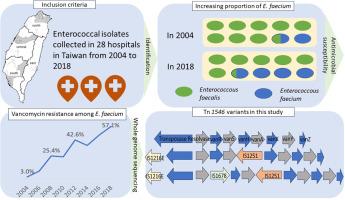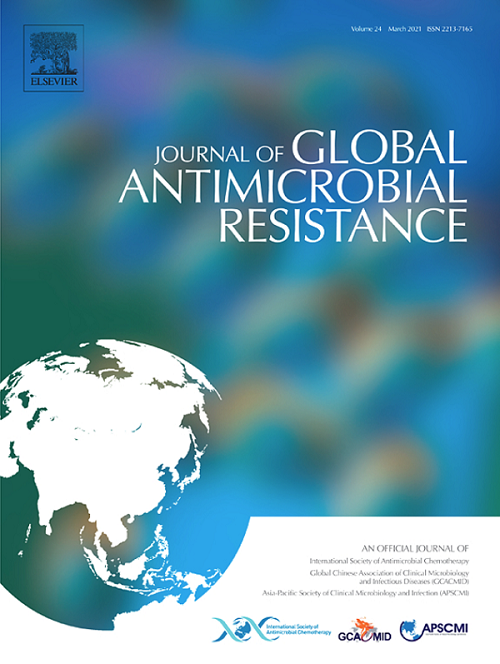Clonal expansion of Tn1546-like transposon-carrying vancomycin-resistant Enterococcus faecium, a nationwide study in Taiwan, 2004-2018
IF 3.7
3区 医学
Q2 INFECTIOUS DISEASES
引用次数: 0
Abstract
Objectives
The prevalence of vancomycin-resistant Enterococcus faecium (VREfm) has increased significantly in Taiwan. We investigated the molecular epidemiology of clinical VREfm isolates to increase our understanding on their spread and changes in population structure over a 14-year span.
Methods
A total of 1113 E. faecium isolates were collected biennially from 2004 to 2018 in Taiwan. MICs were determined by broth microdilution. Whole-genome sequencing (WGS) was performed on 229 VREfm isolates to characterize their genetic environment of vancomycin resistance and wgMLST was used to investigate their clonal relationship.
Results
Among the 229 isolates, ST17 and ST78 predominated, especially during the later years, and their prevalences increased from 14.6% (7/48) and 25.0% (12/48) in 2004–2010 to 47.5% (87/181) and 29.8% (54/181) in 2012–2018, respectively. Four types of vanA-carrying Tn1546 variants were detected, with type 1 and type 2 predominated. Type 1 Tn1546 contained an addition of IS1251, while type 2 resembled type 1 but had an addition of IS1678. wgMLST revealed several distinct clusters of ST17 and ST78 isolates, with type 1 Tn1546-harbouring ST17-Cluster 16 being the largest and most widespread clones throughout the study years. Type 2 Tn1546-carrying ST78 became a predominant clone (Cluster 21) after 2012. Isolates within these clusters are highly similar despite being from different hospitals, regions, and study year.
Conclusion
The increase of VREfm in Taiwan was attributed to horizontal transfer of vanA-carrying Tn1546 variants between different STs and spread of persistent clones. This study highlights the importance of integrating WGS into surveillance to combat antimicrobial resistance.

Tn1546 样转座子携带耐万古霉素粪肠球菌的克隆扩增,2004-2018 年台湾全国性研究。
目的:耐万古霉素肠球菌(VREfm)在台湾的流行率显著增加。我们研究了临床 VREfm 分离物的分子流行病学,以加深我们对 14 年间其传播和种群结构变化的了解:方法:2004 年至 2018 年期间,我们每两年在台湾收集一次粪肠球菌分离株,共计 1113 株。采用肉汤微稀释法测定 MIC。对 229 株 VREfm 分离物进行了全基因组测序(WGS),以确定其万古霉素耐药基因环境的特征,并使用 wgMLST 调查其克隆关系:结果:在229株分离株中,ST17和ST78占多数,尤其是在后期,其流行率分别从2004-2010年的14.6%(7/48)和25.0%(12/48)上升到2012-2018年的47.5%(87/181)和29.8%(54/181)。检测到四种携带vanA的Tn1546变体,其中以1型和2型为主。wgMLST 发现了几个不同的 ST17 和 ST78 分离物群,其中 1 型 Tn1546 携带 ST17-Cluster 16 是整个研究年份中最大、最普遍的克隆。携带 ST78 的 2 型 Tn1546 在 2012 年后成为主要克隆(群落 21)。尽管来自不同的医院、地区和研究年份,但这些群组中的分离菌高度相似:结论:台湾 VREfm 的增加归因于携带 vanA 的 Tn1546 变体在不同 ST 之间的水平转移和持续性克隆的传播。本研究强调了将 WGS 纳入抗菌药耐药性监测的重要性。
本文章由计算机程序翻译,如有差异,请以英文原文为准。
求助全文
约1分钟内获得全文
求助全文
来源期刊

Journal of global antimicrobial resistance
INFECTIOUS DISEASES-PHARMACOLOGY & PHARMACY
CiteScore
8.70
自引率
2.20%
发文量
285
审稿时长
34 weeks
期刊介绍:
The Journal of Global Antimicrobial Resistance (JGAR) is a quarterly online journal run by an international Editorial Board that focuses on the global spread of antibiotic-resistant microbes.
JGAR is a dedicated journal for all professionals working in research, health care, the environment and animal infection control, aiming to track the resistance threat worldwide and provides a single voice devoted to antimicrobial resistance (AMR).
Featuring peer-reviewed and up to date research articles, reviews, short notes and hot topics JGAR covers the key topics related to antibacterial, antiviral, antifungal and antiparasitic resistance.
 求助内容:
求助内容: 应助结果提醒方式:
应助结果提醒方式:


